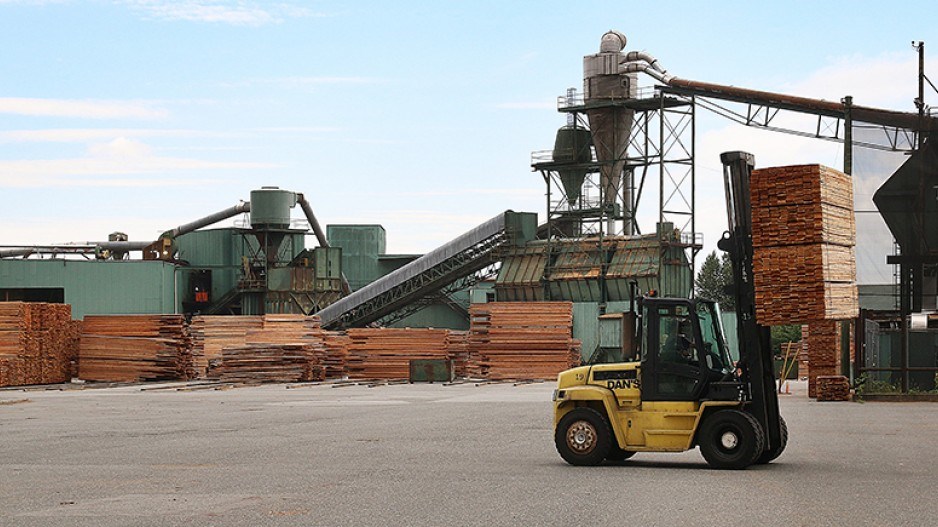An economic recovery in the U.S. will take longer than expected, Goldman Sachs predicted last week, due to a failure by governments in the U.S. to contain the spread of the COVID-19 virus.
That will curb Canada’s economic recovery as well. It’s not just that borders between the two countries will remain closed for longer – it also means less demand for key Canadian exports.
The U.S. accounts for about 75% of Canada’s merchandise exports and 50% of B.C.’s. So its inability to contain the pandemic will have consequences for some B.C. exports.
The hardest hit sector has been, and will continue to be, forestry, followed by aluminum.
According to BC Stats, key B.C. exports – notably forestry products – were down dramatically in May, compared with the same period in 2019. The one sector to experience significant export increases to the U.S. were agricultural products and farmed, canned and smoked salmon.
As of May 2020, B.C. dimensional lumber, cedar shake and plywood exports to the U.S. were down by 30%, 35% and 26%, respectively, and log exports were down by 72%.
Newsprint and paper exports to the U.S. were down 80% and 26%, respectively. The only sector in the U.S. that appeared to experience an uptick was the home repair and renovation sector, which isn’t surprising given how many homeowners were stuck at home for weeks on end.
“We’ve seen the end of Q2 pick up a little bit,” said Susan Yurkovich, CEO of the Council of Forest Industries (COFI). “Now that we’re seeing states shut down again, who knows?
“What we had seen as a bit of a pickup, both in R and R (repair and renovation) and the homebuilders starting to get back to work, we could end up being in a kind of a W, but we actually don’t know.”
The COVID-19 virus may have originated in China, but the United States has eclipsed it and every other country in terms of both infection rates and deaths. The U.S. last week had about 11.5 million confirmed cases and 130,000 deaths, according to Johns Hopkins University, compared with China’s 85,000 confirmed cases and 4,641 deaths.
New cases continued to increase last week in roughly 38 states, meaning many have not yet even flattened the curve. As a result, some cities and states are reinstating restrictions.
“It’s concerning for sure,” said economist Jock Finlayson, executive vice-president and chief policy officer of the Business Council of British Columbia (BCBC). “The U.S. seems to be failing to contain this virus at a time when almost all the other advanced economies have been successful in doing so.
“From a Canadian perspective, just looking inside our own borders, we seem to have gotten through the worst of this pandemic-related economic downturn. The prevailing view is we’re through the worst of it in terms of what’s going on inside Canada, and we can look forward to some recovery of activity over the second half of the year and some positive growth in 2021.”
Goldman Sachs warned last week that the American economic rebound in the third quarter will be lower and slower than expected. The investment bank still expects a recovery in the American economy in the third quarter – but with a 25% annualized growth rate, rather than the 33% rebound it had expected.
“Previously they were expecting a dramatic surge in economic activity in the third quarter of 2020 in the United States,” Finlayson said. “They’re still expecting the surge, but it’s going to be more muted. That’s pretty alarming when the top investment bank comes out with, essentially, a shot across the bow.
“To the extent that the U.S. economy underperforms, housing starts come in below the levels we were hoping for,” Finlayson said. “That’s bad news for the Canadian lumber industry because U.S. housing activity plays a big role in the demand for lumber exported from Canada.
“To the extent the U.S. economy is weaker, that will have a knock-on negative effect across natural gas, oil, even agrifood products , pulp and paper, minerals, etcetera.”
The U.S. is not a major market for B.C.’s two biggest mining exports: copper and metallurgical coal. But it is a major market for B.C. industrial metals like zinc and molybdenum, export volumes of which were down 23% and 48%, respectively, in May compared with May 2019.
The biggest concern for B.C.’s mining and smelting sector is aluminum exports, which have lately been the target of American anti-dumping duties.
As for natural gas, the U.S. is currently Canada’s sole export market, with the exception of small amounts of LNG produced by FortisBC, which are exported to China.
Ian Archer, director for North American natural gas for IHS Markit, doesn’t expect the slower economic recovery in the U.S. to have much of an impact on natural gas exports. Volumes probably won’t change much, though producers in B.C. might get higher prices.
That’s because a global oil price shock has resulted in a dramatic reduction in shale oil production in the U.S., where natural gas is produced as a byproduct of shale oil production. Less natural gas being produced is expected to boost North American natural gas prices.
“There’s a little bit of an upside … in the fact that we could see some higher prices this winter,” Archer said. “There might not be a lot of exports out of Canada, but there is some potential for producers in B.C. to see higher prices this winter.” •




